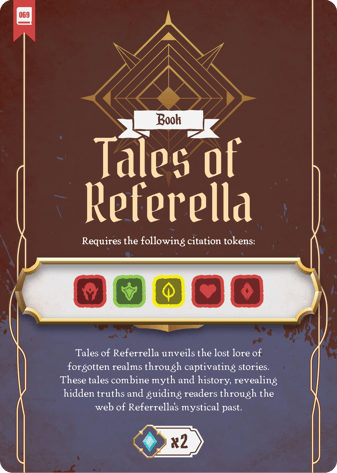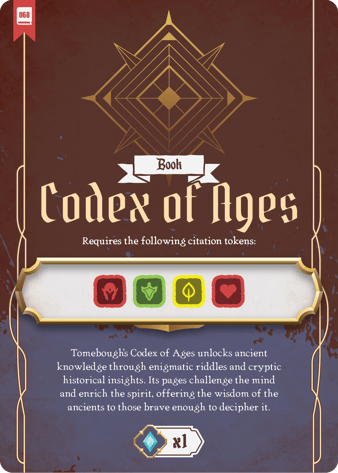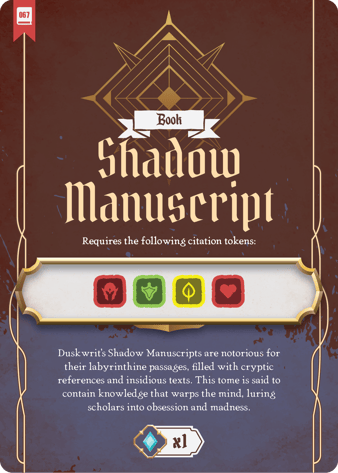
Books
Deep within the Grand Archive, where the scent of aged parchment lingers in the air and enchanted quills etch knowledge into bound volumes, lies an endless repository of tomes, grimoires, and ancient manuscripts. Books have long been the foundation of knowledge, their pages preserving wisdom both mundane and mystical, safeguarding spells, philosophies, and chronicles of forgotten civilizations. Whether inscribed upon moonlit vellum, sealed within iron-clad grimoires, or whispered into existence by librarians of the ethereal plane, books remain one of the most reliable sources of recorded knowledge. Here, we present a curated collection of revered texts, enchanted psalms, and divine revelations, each an echo of ancient pacts and celestial wisdom.
Unlike traditional sources, books often require special citation elements, including:
An author or scribe—though some tomes have no known writer, existing as if conjured from the ether.
An edition or translation, particularly if the book has been reinterpreted over the ages.
A place of publication, whether a mortal city or an ethereal archive.
The publisher or enchanter’s sigil, denoting its origin and authenticity.
Below, you will find examples of various books and manuscripts, cited in different styles to illustrate their variance in academic writing.
Scholarly Treatises
These weighty tomes, often bound in enchanted leather and locked with celestial sigils, contain profound insights into cosmic laws, magical theory, and the nature of reality itself. Found in wizard towers, forgotten archives, or the celestial libraries of starborne sages, these books serve as foundational texts for scholars and mystics alike.
Example (Harvard Style): Starborn, E. (Year 1298). The Principles of Astral Convergence. Celestial Quill Press.
Grimoires & Spellbooks
Grimoires are not merely books—they are repositories of raw power, their pages inscribed with spells, curses, and incantations whispered by entities beyond mortal comprehension. Many are warded against the unworthy, their knowledge revealed only to those who can break their seals.
Example (APA 7th Edition): Ravenborn, L. (Year 1442). The Shadowbinder’s Grimoire: A Study of Forbidden Magics (5th ed.). Midnight Tomes Publishing.
Bestiaries & Creature Compendiums
These books are more than simple catalogs of monstrous beings—they are warnings, survival guides, and testaments to encounters between scholars and the strange. Their pages may shift on their own, updating as new creatures emerge from the void.
Example (MLA): Thornroot, H. A Scholar’s Guide to Beasts of the Enchanted Realms. Eldertome Press, Year 1382.
Histories & Chronicles
Time erodes memories, but history carved into parchment remains unyielding. These chronicles recount wars between celestial empires, the rise and fall of forgotten civilizations, and the deeds of heroes whose names have long since faded into dust.
Example (Chicago Style): Moonwhisper, T. 1156. The Rise and Fall of the Starlit Kingdom. Celestial Quill Press.
Atlases & Cartographic Records
Not all lands exist upon a single plane of existence. Some shift between realities, vanish at moonrise, or appear only in the dreams of wanderers. Atlases and maps, often scribbled by explorers on the edge of madness, provide glimpses into lands unseen and paths untrodden.
Example (Vancouver Style): Wayfarer L. The Ethereal Atlas: Mapping the Veil Between Worlds. Astral Compass Publishing; 1622.
Religious & Sacred Texts
Whether written in the blood of saints, etched into divine crystal, or spoken into existence by celestial voices, sacred books hold the commandments of gods and the revelations of prophets. Some are believed to sing their truths aloud to those deemed worthy.
Example (IEEE Style): High Priestess Elara, The Eternal Verses of the Sun-God. Solarium Archives, Year 890.
Philosophical Discourses
These books contain the musings of sages and scholars who dare to question fate, destiny, and the will of the cosmos itself. Some claim that reading these texts too deeply can drive a scholar to madness—or enlightenment.
Example (Turabian Style): Eldrin, M., ed. Reflections Upon the Infinite: A Collection of Celestial Wisdom. Grand Library of Etherea, Year 1112.
Epics & Mythic Tales
These stories, penned by bardic scholars and temple scribes, are not merely entertainment but prophecy. Their heroes and villains may well be real figures, trapped in the ever-repeating cycles of history. To read such a tale is to watch fate itself unfold.
Example (APA 6th Edition): Stormweaver, A. (Year 920). The Song of the Fallen Stars: A Tale of Heroes and Gods. Starlit Scrolls Press.
Codices of Lost Knowledge
Often discovered buried beneath ancient ruins, concealed behind wards of protection, or guarded by beings who speak in riddles, these books contain the knowledge of lost civilizations, preserved beyond time’s reach. Some scholars believe these books find their readers, not the other way around.
Example (Harvard Style): Runebinder, V. (Year 875). Echoes of the First Age: A Study of the Lost Civilizations. Arcane Chronicle Publications.
The Librarian’s Compendium
This book is not simply a record of knowledge—it is knowledge incarnate. A masterwork written by librarians of the unseen, it contains annotations, cross-references, and whispers of books that have yet to be written.
Example (Chicago Style): Archivist Fenwyn, ed. The Librarian’s Compendium: A Master Index of the Grand Archive. Eldertome Publishing, Year 1500.
Books are the lifeblood of scholars, the foundation of civilizations, and the vessels of ancient knowledge. Whether bound in enchanted leather, wrapped in shadow, or guarded within the Grand Archive’s deepest vaults, these tomes serve as portals to wisdom. By properly citing treatises, grimoires, and forgotten epics, scholars ensure that the voices of the past endure, guiding the future toward enlightenment—or ruin. But beware—some books read their readers as much as they are read. Knowledge is power, and power is seldom without consequence.







